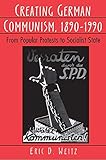Creating German Communism, 1890-1990 : From Popular Protests to Socialist State / Eric D. Weitz.
Material type: TextPublisher: Princeton, NJ : Princeton University Press, [2021]Copyright date: ©1997Description: 1 online resource (472 p.) : 30 halftones 10 line drawings 7 tablesContent type:
TextPublisher: Princeton, NJ : Princeton University Press, [2021]Copyright date: ©1997Description: 1 online resource (472 p.) : 30 halftones 10 line drawings 7 tablesContent type: - 9780691228129
- 335.43/0943 22
- online - DeGruyter
| Item type | Current library | Call number | URL | Status | Notes | Barcode | |
|---|---|---|---|---|---|---|---|
 eBook
eBook
|
Biblioteca "Angelicum" Pont. Univ. S.Tommaso d'Aquino Nuvola online | online - DeGruyter (Browse shelf(Opens below)) | Online access | Not for loan (Accesso limitato) | Accesso per gli utenti autorizzati / Access for authorized users | (dgr)9780691228129 |
Frontmatter -- CONTENTS -- LIST OF ILLUSTRATIONS -- LIST OF TABLES -- ACKNOWLEDGMENTS -- LIST OF ABBREVIATIONS -- INTRODUCTION -- CHAPTER 1 Regimes of Repression, Repertoires of Resistance -- CHAPTER 2 War and Revolution and the Genesis of German Communism -- CHAPTER 3 Reconstructing Order: State and Managerial Strategies in the Weimar Republic -- CHAPTER 4 Contesting Order: Communists in the Workplace -- CHAPTER 5 Contesting Order: Communists in the Streets -- CHAPTER 6 The Gendering of German Communism -- CHAPTER 7 Forging a Party Culture -- CHAPTER 8 The Anni terribili: Communists under Two Dictatorships -- CHAPTER 9 The Weimar Legacy and the Road to the DDR 1945-49 -- CHAPTER 10 The Primacy of Politics: State and Society in the DDR -- CONCLUSION The End of a Tradition -- BIBLIOGRAPHY -- INDEX -- ABOUT THE AUTHOR
restricted access online access with authorization star
http://purl.org/coar/access_right/c_16ec
Eric Weitz presents a social and political history of German communism from its beginnings at the end of the nineteenth century to the collapse of the German Democratic Republic in 1990. In the first book in English or in German to explore this entire period, Weitz describes the emergence of the Communist Party of Germany (KPD) against the background of Imperial and Weimar Germany, and clearly explains how the legacy of these periods shaped the character of the GDR to the very end of its existence. In Weimar Germany, social democrats and Germany's old elites tried frantically to discipline a disordered society. Their strategies drove communists out of the workplace and into the streets, where the party gathered supporters in confrontations with the police, fascist organizations, and even socialists and employed workers. In the streets the party forged a politics of display and spectacle, which encouraged ideological pronouncements and harsh physical engagements rather than the mediation of practical political issues. Male physical prowess came to be venerated as the ultimate revolutionary quality. The KPD's gendered political culture then contributed to the intransigence that characterized the German Democratic Republic throughout its history. The communist leaders of the GDR remained imprisoned in policies forged in the Weimar Republic and became tragically removed from the desires and interests of their own populace.
Mode of access: Internet via World Wide Web.
In English.
Description based on online resource; title from PDF title page (publisher's Web site, viewed 30. Aug 2021)


